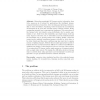Free Online Productivity Tools
i2Speak
i2Symbol
i2OCR
iTex2Img
iWeb2Print
iWeb2Shot
i2Type
iPdf2Split
iPdf2Merge
i2Bopomofo
i2Arabic
i2Style
i2Image
i2PDF
iLatex2Rtf
Sci2ools
AVSS
2006
IEEE
2006
IEEE
3D Human Motion Analysis in Monocular Video Techniques and Challenges
Extracting meaningful 3D human motion information from video sequences is of interest for applications like intelligent humancomputer interfaces, biometrics, video browsing and indexing, virtual reality or video surveillance. Analyzing videos of humans in unconstrained environments is an open and currently active research problem, facing outstanding scientific and computational challenges. The proportions of the human body vary largely across individuals, due to gender, age, weight or race. Aside from this variability, any single human body has many degrees of freedom due to articulation and the individual limbs are deformable due to moving muscle and clothing. Finally, real-world events involve multiple interacting humans occluded by each other or by other objects and the scene conditions may also vary due to camera motion or lighting changes. All these factors make appropriate models of human structure, motion and action difficult to construct and difficult to estimate from images. ...
| Added | 10 Jun 2010 |
| Updated | 10 Jun 2010 |
| Type | Conference |
| Year | 2006 |
| Where | AVSS |
| Authors | Cristian Sminchisescu |
Comments (0)

